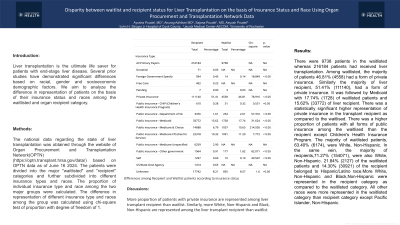Sunday Poster Session
Category: Liver
P1171 - Disparity between waitlist and recipient status for Liver Transplantation on the basis of Insurance Status and Race Using Organ Procurement and Transplantation Network Data
Sunday, October 27, 2024
3:30 PM - 7:00 PM ET
Location: Exhibit Hall E

Has Audio

Ayusha Poudel, MD
Cook County Health
Chicago, IL
Presenting Author(s)
Ayusha Poudel, MD1, Anurag Adhikari, MD2, Sajana Poudel, MD3, Aayush Poudel, BSc4
1Cook County Health, Chicago, IL; 2NYC Health + Hospitals/Jacobi, New York, NY; 3John H. Stroger, Jr. Hospital of Cook County, Chicago, IL; 4University of Rochester, Charlotte, NC
Introduction: Liver transplantation is the ultimate life saver for patients with end-stage liver disease. Several prior studies have demonstrated significant differences based on racial, gender and socioeconomic demographic factors. We aim to analyze the difference in representation of patients on the basis of their insurance status and races among the waitlisted and organ recipient category.
Methods: The national data regarding the state of liver transplantation was obtained through the website of Organ Procurement and Transplantation Network(OPTN) (https://optn.transplant.hrsa.gov/data/) based on OPTN data as of June 16 2024. The patients were divided into the major "waitlisted" and "recipient" categories and further subdivided into different insurance types and races. The proportion of individual insurance type and race among the two major groups were calculated. The difference in representation of different insurance type and races among the group was calculated using chi-square test of proportion with degree of freedom of 1.
Results: There were 9738 patients in the waitlisted whereas 216184 patients had received liver transplantation. Among waitlisted, the majority of patients 46.81% (4558) had a form of private insurance. Similarly the majority of liver recipient, 51.41% (111140), had a form of private insurance. It was followed by Medicaid with 17.74% (1728) of waitlisted patients and 15.62% (33772) of liver recipient. There was a statistically significant higher representation of private insurance in the transplant recipient as compared to the waitlised. There was a higher proportion of patients with all forms of public insurance among the waitlised than the recipient except Children's Health Insurance Program. The majority of waitlisted patients, 63.40% (6174), were White, Non-Hispanic. In the same vein, the majority of recipients,71.27% (154071), were also White, Non-Hispanic. 21.84% (2127) of the waitlisted patients and 14.30% (30921) of the recipient belonged to Hispanic/Latino race.More White, Non-Hispanic and Black,Non-Hispanic were represented in the recipient category as compared to the waitlisted category. All other races were more represented in the waitlisted category than recipient category except Pacific Islander, Non-Hispanic.
Discussion: More proportion of patients with private insurance are represented among liver transplant recipient than waitlist. Similarly, more White, Non-Hispanic and Black, Non-Hispanic are represented among the liver transplant recipient than waitlist.
Note: The table for this abstract can be viewed in the ePoster Gallery section of the ACG 2024 ePoster Site or in The American Journal of Gastroenterology's abstract supplement issue, both of which will be available starting October 27, 2024.
Disclosures:
Ayusha Poudel, MD1, Anurag Adhikari, MD2, Sajana Poudel, MD3, Aayush Poudel, BSc4. P1171 - Disparity between waitlist and recipient status for Liver Transplantation on the basis of Insurance Status and Race Using Organ Procurement and Transplantation Network Data, ACG 2024 Annual Scientific Meeting Abstracts. Philadelphia, PA: American College of Gastroenterology.
1Cook County Health, Chicago, IL; 2NYC Health + Hospitals/Jacobi, New York, NY; 3John H. Stroger, Jr. Hospital of Cook County, Chicago, IL; 4University of Rochester, Charlotte, NC
Introduction: Liver transplantation is the ultimate life saver for patients with end-stage liver disease. Several prior studies have demonstrated significant differences based on racial, gender and socioeconomic demographic factors. We aim to analyze the difference in representation of patients on the basis of their insurance status and races among the waitlisted and organ recipient category.
Methods: The national data regarding the state of liver transplantation was obtained through the website of Organ Procurement and Transplantation Network(OPTN) (https://optn.transplant.hrsa.gov/data/) based on OPTN data as of June 16 2024. The patients were divided into the major "waitlisted" and "recipient" categories and further subdivided into different insurance types and races. The proportion of individual insurance type and race among the two major groups were calculated. The difference in representation of different insurance type and races among the group was calculated using chi-square test of proportion with degree of freedom of 1.
Results: There were 9738 patients in the waitlisted whereas 216184 patients had received liver transplantation. Among waitlisted, the majority of patients 46.81% (4558) had a form of private insurance. Similarly the majority of liver recipient, 51.41% (111140), had a form of private insurance. It was followed by Medicaid with 17.74% (1728) of waitlisted patients and 15.62% (33772) of liver recipient. There was a statistically significant higher representation of private insurance in the transplant recipient as compared to the waitlised. There was a higher proportion of patients with all forms of public insurance among the waitlised than the recipient except Children's Health Insurance Program. The majority of waitlisted patients, 63.40% (6174), were White, Non-Hispanic. In the same vein, the majority of recipients,71.27% (154071), were also White, Non-Hispanic. 21.84% (2127) of the waitlisted patients and 14.30% (30921) of the recipient belonged to Hispanic/Latino race.More White, Non-Hispanic and Black,Non-Hispanic were represented in the recipient category as compared to the waitlisted category. All other races were more represented in the waitlisted category than recipient category except Pacific Islander, Non-Hispanic.
Discussion: More proportion of patients with private insurance are represented among liver transplant recipient than waitlist. Similarly, more White, Non-Hispanic and Black, Non-Hispanic are represented among the liver transplant recipient than waitlist.
Note: The table for this abstract can be viewed in the ePoster Gallery section of the ACG 2024 ePoster Site or in The American Journal of Gastroenterology's abstract supplement issue, both of which will be available starting October 27, 2024.
Disclosures:
Ayusha Poudel indicated no relevant financial relationships.
Anurag Adhikari indicated no relevant financial relationships.
Sajana Poudel indicated no relevant financial relationships.
Aayush Poudel indicated no relevant financial relationships.
Ayusha Poudel, MD1, Anurag Adhikari, MD2, Sajana Poudel, MD3, Aayush Poudel, BSc4. P1171 - Disparity between waitlist and recipient status for Liver Transplantation on the basis of Insurance Status and Race Using Organ Procurement and Transplantation Network Data, ACG 2024 Annual Scientific Meeting Abstracts. Philadelphia, PA: American College of Gastroenterology.
